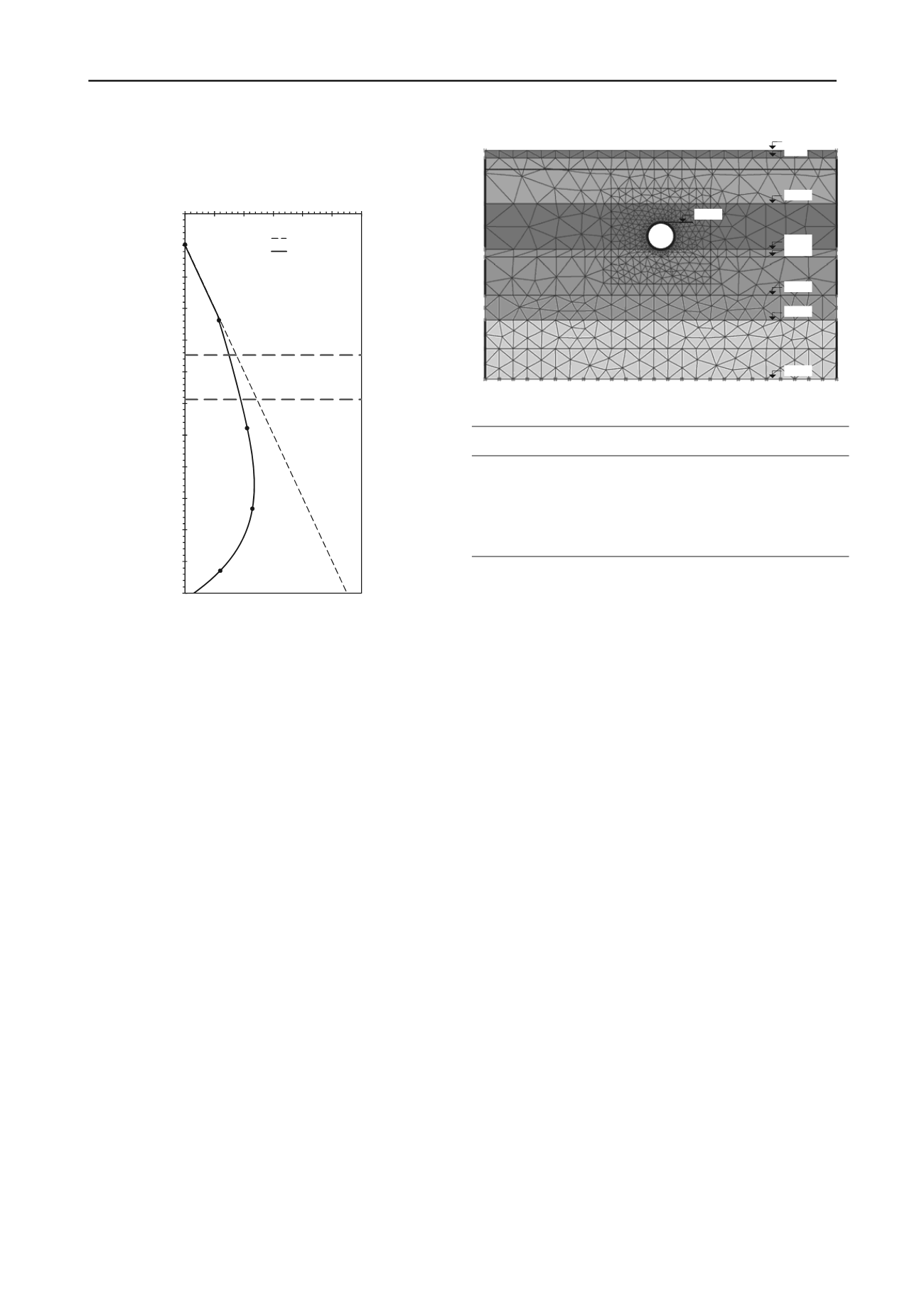
1766
Proceedings of the 18
th
International Conference on Soil Mechanics and Geotechnical Engineering, Paris 2013
from a depth of 7m down, reaching up to 400 kPa at a depth of
56m. The phreatic level depth (NAF) varies from 3 to 5m.
0
5
10
15
20
25
30
35
40
45
50
55
60
0 100 200 300 400 500 600
Profundidad,m
PresióndePoro, kPa
Hidrostática
Piezométrica
Por pressure, kPa
Hydrostatic
Piezometric
Depth, m
Depth, m
Figure 1. Pore pressure profile
An indirect and approximate way to forecast future pore
pressure profile consists of employing a numerical model to
evaluate the magnitude of the piezometric drawdown required
to induce the regional subsidence that is expected to take place
at the end of the design period (50 years) in the area. Such
regional subsidence can be estimated from surveys performed
on surface references and referred to a deep benchmark. The
estimated regional subsidence after 50 years varies from 3.8 to
5.8 m.
3 NUMERICAL MODELLING
3.1 Software
A numerical model was developed using the Plaxis 2D software
(
. Since a long term assessment is required, the
analysis was conducted in terms of effective stresses, taking into
account drained parameters and non-drained initial conditions
(Plaxis bv 2008, Schweiger 2005, Rodríguez-Rebolledo 2011).
3.2 General characteristics of the model
Figure 2 shows the finite element mesh and Table 1 presents the
soil properties of the different layers used in the numerical
model. Mohr-Coulomb and Soft-Soil type models were
employed for hard and soft soils, respectively.
The modelling is performed in several stages related to the
constructive procedure of the tunnel:
Stage 1. Tunnel excavation and installation of primary
liner.
The construction condition right after installation of the
primary liner is modelled. In order to take into account the
effect of the joints between segments, a reduction factor of
stiffness of the ring parameter (
), estimated by means of an
interactive procedure, is introduced. The procedure consists of
varying the magnitude of such parameter so that convergence is
obtained between the geotechnical and the structural models. A
value of
= 0.2 was obtained.
E
C.S.
B
1
B
2
C
F
D
-2.0m
0.0m
-28.0m
-14.0m
-60.0m
-38.0m
-44.5m
-26.0m
-19.0m
Figure 2. Finite element mesh
Table 1. Soil properties for the numerical modelling
Layer Model
*
*
OCR
’
ur
K
o
=K
o
nc
k
x
=k
y
m/day
CS MC ---
---
---
0.30 ---
1.00 1x10
-2
B
1
SS 0.043 0.260 1.0 ---
0.15 0.43 1x10
-5
B
2
SS 0.035 0.250 1.0 ---
0.15 0.43 1x10
-5
C MC ---
---
---
0.33 ---
0.50 1x10
-1
D SS 0.026 0.227 1.0 ---
0.15 0.43 1x10
-5
E MC ---
---
---
0.33 ---
0.50 1x10
-1
F
SS 0.023 0.201 1.0 ---
0.15 0.43 1x10
-4
* = slope of the swelling line
* = slope of the normal compression line
OCR
= over consolidation ratio
’ = Poisson’s ratio
ur
= unload-reload Poisson’s ratio
K
0
= coefficient of earth pressure at rest
K
0
nc
= lateral earth pressure at rest for
normally consolidated states
k
x
=
k
y
= permeability coefficients for
x
and
y
directions
MC = Mohr-Coulomb model
SS = Soft-Soil model
Stage 2. Consolidation of the medium due to the excess of
pore pressure generated by the excavation of the tunnel and
installation of the primary liner.
At this stage it is assumed that
the excess of pore pressure generated by the excavation and
installation of the primary liner is dissipated before the
secondary liner is built (Gutiérrez and Schmitter, 2010) and
therefore that it will only affect the primary liner.
Stage 3. Construction of the secondary liner.
The
construction of the definitive liner is modelled at this stage.
Interface elements between primary and secondary liners are
used to simulate the discontinuity between both liners.
Stage 4. Consolidation of the medium due to excess of pore
pressure generated by construction of the secondary liner and
piezometric drawdown.
The behaviour of the tunnel is predicted
for the next 50 years. In order to do so, a reduction of the elastic
modulus of the concrete due to plastic flow has to be applied
(F
R
, Table 2). The regional subsidence obtained from the
numerical model for a total drawdown of the current
piezometric conditions was equal to 6.2m. This value is close to
the maximum value estimated from field measurements for a
period of time equal to 50 years (3.8-5.8m, section 2.2).
The primary liner was modelled using volume elements and
the secondary liner using plate type elements. Two interfaces
were also included: a primary liner-soil interface and, as
mentioned, a secondary liner-primary liner interface.
3.3 Results and discussion
Figure 3 shows the excess pore pressure around the tunnel
originated by construction itself (stage 1). Underneath the
tunnel floor, it can be observed that an excess of positive pore
pressure is generated due to unloading, whereas close to the
lateral sides of the tunnel excess of negative pore pressure
develops due to loading. This means that the unloading
associated to the removal of the weight of the excavated soil
produces an upward general movement of the tunnel, Figure 4
(“bubble” effect, Auvinet and Rodríguez-Rebolledo, 2010).


